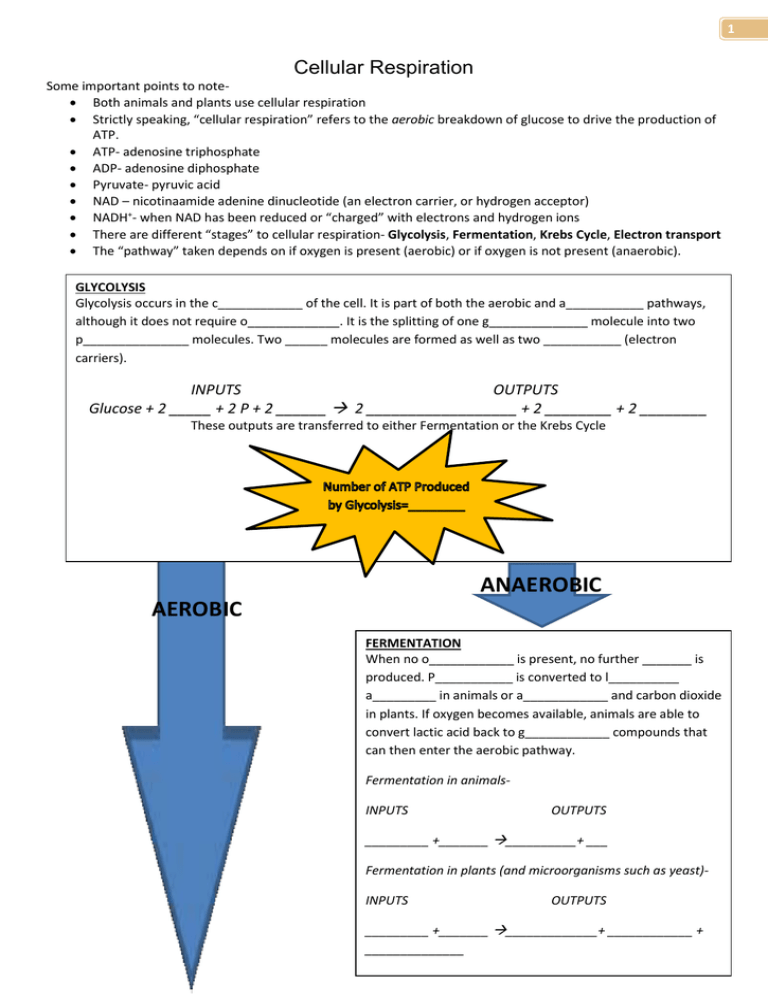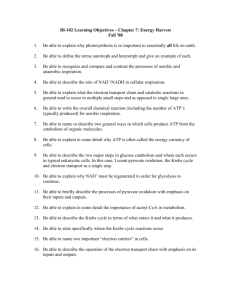Cellular Respiration Process Flowchart
advertisement

1 Cellular Respiration Some important points to note Both animals and plants use cellular respiration Strictly speaking, “cellular respiration” refers to the aerobic breakdown of glucose to drive the production of ATP. ATP- adenosine triphosphate ADP- adenosine diphosphate Pyruvate- pyruvic acid NAD – nicotinaamide adenine dinucleotide (an electron carrier, or hydrogen acceptor) NADH+- when NAD has been reduced or “charged” with electrons and hydrogen ions There are different “stages” to cellular respiration- Glycolysis, Fermentation, Krebs Cycle, Electron transport The “pathway” taken depends on if oxygen is present (aerobic) or if oxygen is not present (anaerobic). GLYCOLYSIS Glycolysis occurs in the c____________ of the cell. It is part of both the aerobic and a___________ pathways, although it does not require o_____________. It is the splitting of one g______________ molecule into two p_______________ molecules. Two ______ molecules are formed as well as two ___________ (electron carriers). INPUTS OUTPUTS Glucose + 2 _____ + 2 P + 2 ______ 2 __________________ + 2 ________ + 2 ________ These outputs are transferred to either Fermentation or the Krebs Cycle ANAEROBIC AEROBIC FERMENTATION When no o____________ is present, no further _______ is produced. P___________ is converted to l__________ a_________ in animals or a____________ and carbon dioxide in plants. If oxygen becomes available, animals are able to convert lactic acid back to g____________ compounds that can then enter the aerobic pathway. Fermentation in animalsINPUTS OUTPUTS _________ +_______ __________+ ___ Fermentation in plants (and microorganisms such as yeast)INPUTS OUTPUTS _________ +_______ _____________+ ____________ + ______________ 2 TRANSFER TO THE MITOCHONDRIA For the “outputs” from Glycolysis to be transferred from the cytosol to the mitochondria one ______ molecule must be “paid” for every p_____________ molecule. Hence it costs two ATP (technically these were the ones made during glycolysis so no ATP has been produced and made available for the cell yet). THE KREBS CYCLE The Krebs Cycle occurs in the m____________ of the cell. It is one part of the aerobic pathway. In the mitochondria, each p__________ (3 Carbon) molecule is oxidised to form a__________ (2 Carbon), NADH+ and CO2. Acetyl (2C) combines with c_____________ ___ to form acetyl CoA which can enter the Krebs Cycle. In each “turn” of the Krebs Cycle, one acetyl CoA enters the cycle and one ______ is formed. In addition 4 NAD become _______ and 2 molecules of _____ are produced. Two p_________ molecules are broken producing 2 ____. ELECTRON TRANSPORT The electron transport occurs in the inner _________________of the _____________________ and is a system of electron ______________ . Electrons donated from _______________________ (NADH) created during g_______________ and the K___________ C__________ . As the electrons are passed from one compound to the next in the chain, some of the energy is used to pump h____________ ions (protons) out of the mitochondrial matrix forming potential (stored) energy. As the protons pass back into the matrix, ______ is made from _______. At the end of the chain, e_____________ are transferred to o____________ and bonded with h____________ to form w_____________. 3 • Starting materials before glycolysis- 1 Glucose, 2ADP, 2NAD+ • Ending materials after glycolysis- 2 Pyruvate, 2ATP, 2NADH GLYCOLYSIS TRANSFER TO MITOCHONDRIA KREBS CYCLE ELECTRON TRANSPORT • Minus 2ATP • Hence the 2 ATP that were made in glycolysis have been used • 2 Pyruvate change to 2 Acetyl • 2 NAD+ change to 2 NADH • 2 CO2 are formed. • The 2 Acetyl changes to 2Acetyl CoA • 2 Acetyl CoA changes to 2 CO2. This releases ONE ATP. • 2 ADP converted to TWO ATP • 4 NADH produced • 8NADH are converted to 8NAD+ • 8NAD are made into ATP • 32 ATP molecules produced from ADP TOTAL EQUATION C6H12O6 + 6O2 6CO2 + 6H2O + 36 – 38 ATP Glucose + Oxygen Carbon Dioxide + Water + ATP / Energy



